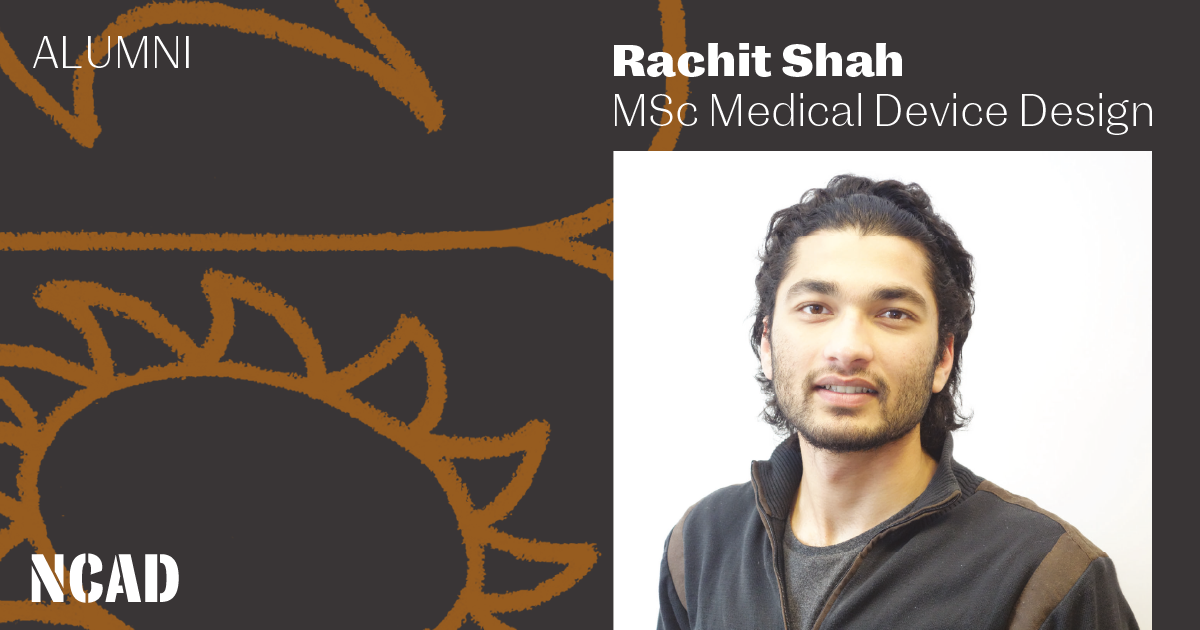Alumni Stories- Rachit Shah
"The pandemic has allowed us all to stare at the various inefficiencies and inequities that exist in our essential systems and services"

Name: Rachit Shah
Current Career: Human-Centred Design Consultant
Graduation Year: 2014
Discipline: Medical Device Design
Location: India / UK
What career path did you want to follow as a child?
Growing up, I had a new career in mind every year. Some of the options on my ever-expanding list included becoming a doctor or an astronaut.
Why did you decide to study at National College of Art & Design?
I started an engineering degree after school, but only because a lot of my schoolmates were doing the same. It was only in my fourth year when I realised that my interest lies in design and innovation. I secured a job to start immediately after my degree, but I knew that I wanted to shift gears and keep learning.
During my last semester in engineering I came across NCAD’s MSc. in Medical Device Design and realised it was exactly what I wanted to do next. I wanted to get into the medical/healthcare field and be part of teams innovating and developing lifesaving interventions.
How did you develop your career towards your current job / practice?
I did my Master’s thesis project on designing a wearable device for people living with dementia, which opened many doors for me immediately after I graduated. I then worked as a design research lead through the college technology transfer office, NCAD Origin8. This allowed me to work for the college and with several innovative business start-ups in Ireland.
After this, I took on a full-time role as a designer at another start-up company in Dublin, developing air quality sensing products for clean rooms, hospital and domestic use.
Following that I worked on systems and service design in the primary healthcare field in developing countries, including volunteering at NGOs in India and working on the design team at Design without Borders Uganda. I then took on the role of Design Lead within an innovation team at Doctors without Borders in Nairobi, Kenya, which put me in the depths of high-intensity humanitarian work, where there is little time to test things but problem solving needs to happen at a rapid rate and scale. I also got involved with several field projects in Mexico, Nigeria, Sudan, DRC and Ethiopia.
Since early 2019 I have been working as a Human-Centred Design consultant for clients operating in the development and humanitarian sectors.
What is the one experience during your time at NCAD that has informed you most in your career / work to date?
The one-month phase of design research I did for my thesis project was the first and only project during the course that we were expected to work on independently from the very start, rather than in small teams. As part of that I got to interview and observe several people caring for people living with dementia, or those who were living with dementia themselves.
Through the Alzheimer’s Society of Ireland I was allowed to work as a volunteer at day care centres around Dublin and do lightweight observational research for my project. That helped me to learn the true value of design research and human-centred design – the experience was definitely the ‘ah ha!’ moment for me as a designer. Since then I have tried to incorporate meaningful, qualitative, deep-dive research into all the projects I have taken up as a professional designer.

If you were chatting with current NCAD students today what is the one piece of advice you would offer?
I would strongly advise students to understand the importance of having users at the centre of all design decisions and making time to understand user perspectives – always! Often clients look to get quick and convenient designs with the assumption that they know their users already – this only leads to bad design in the long run.
Given the global turmoil and change accelerated by the COVID-19 pandemic, what in your opinion are the opportunities for those in creative industries?
The pandemic has opened up many new opportunities because it has allowed us all to stare at the various inefficiencies and inequities that exist in our essential systems and services. We have seen that there is a lot of room for improvement, for example, in healthcare service provision and in the way key communications are taking place.
On the one hand the pandemic, with the help of available technology, has helped in making all things go global – people from different parts of the world can be on the same call in a single click. On the other hand, the magic of in-person discussions and collaborations has gone missing. We need to think creatively about how these post-pandemic, hybrid ways of assembling ourselves can continue to make the world a more reachable and accessible place, while also allowing us to engage in deeper and more immersive ways than what’s currently offered by a virtual meeting.
